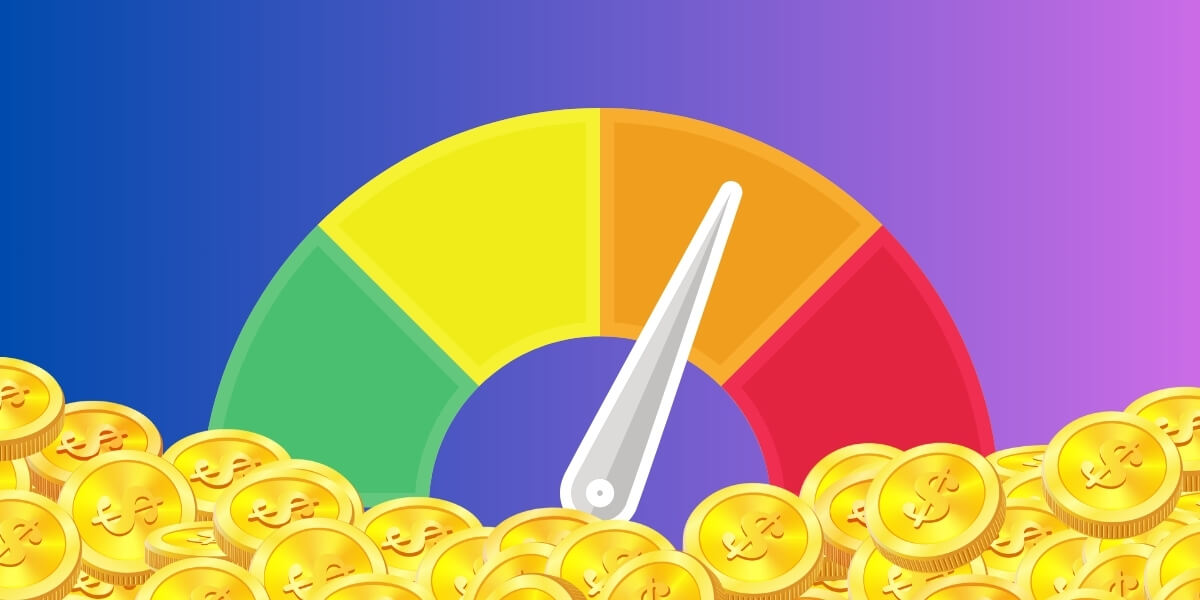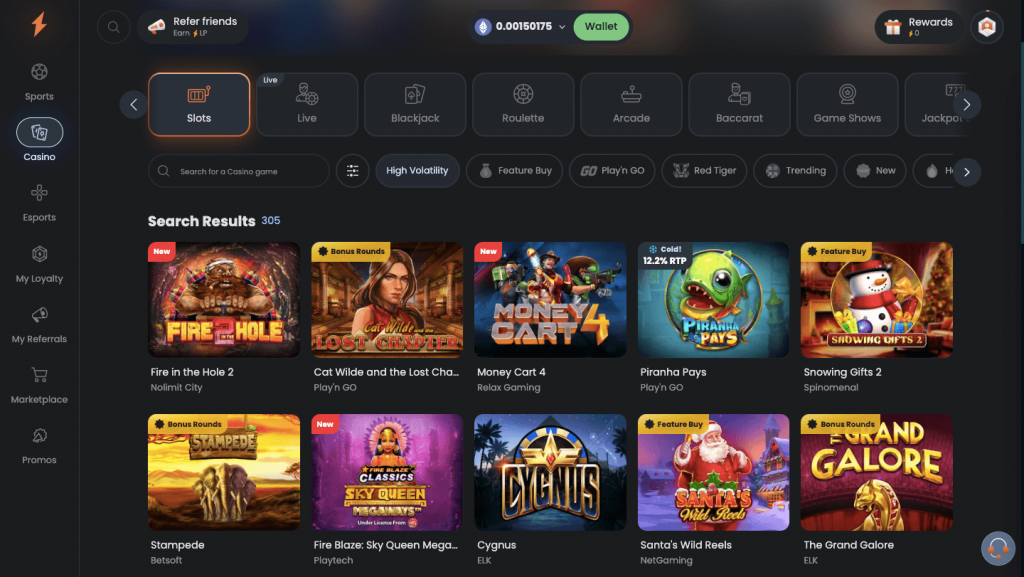
Risk to Reward: Understanding Volatility in Crypto Casino Games
When you start playing different crypto casino games, you’ll quickly notice they are not all created equal.
Aside from featuring different Return-to-Player percentages (RTPs) and mechanics, they also have another vital aspect contributing to the games’ payouts — volatility.
Volatility refers to how often a game pays on average, and mastering it can significantly enhance your gameplay and chances of success.
In this article, I’ll take you through:
- The concept of volatility
- How different levels of volatility affect you as a player
- The best ways to deal with volatility
Ready? Let’s start with the basics:
What Is Volatility in Crypto Casino Games?
Industry experts define volatility as a measure of risk associated with playing a specific casino game, which can be low, medium, or high.
Software developers use the reward and risk ratio to calculate volatility and inform the player about the frequency and the payout size they can expect.
Typically, volatility is discussed a lot in terms of video slots.
Higher volatility slot machines are riskier because they potentially carry bigger wins that don’t trigger that often. Lower volatility games are the opposite, meaning you can expect more frequent but lower returns.
Volatility is also present in the table games. For instance, the straight bet pays 35:1 in roulette and hits less often; hence, it is more volatile than an outside bet with a lower payout (1:1) that occurs more frequently.
However, playing any game, whether a crypto slot or table game, depends mainly on luck. Volatility may partially help you control the risk, but in the end, it’s luck that decides your success, especially with games like slots.
Different Types of Volatility
There are three primary volatility levels in crypto games:
- Low
- Medium
- High
Volatility is mainly associated with slot machines, but you’ll occasionally see some other casino games measured by their volatility.
You should understand how each of them works to be able to choose the game that aligns with your budget, playing style, and expectations.
Let’s look into each level and the different games you’ll find there:
Low-Volatility Games
Low-volatility crypto slot machines are games offering smaller but more frequent payouts. They are considered low-risk and ideal for beginners who don’t want to invest much money and prefer extended gaming sessions.
Prizes are awarded in small increments more frequently throughout the game, approximately on every couple of spins.
Low-volatility slots often boast bonus rounds and other special features, so you can play stress-free and long enough until you unlock any of them.
The maximum payout of these games is usually between 200x and 500x of your initial bet, significantly lower than the payout you can receive hitting the jackpot on a high-variance slot.
The best-case scenario is that you’ll earn the amount you started with or up to 25% more than that.
As you can imagine, low-volatility games won’t suit high-rollers going after those big wins and don’t mind losing enormous amounts of money.
Some of the most famous low-volatility slots you’ll find include:
- Neon Reels (Microgaming)
- Starburst (NetEnt)
- Aztec Adventure (BF Games)
- Mayan Ritual (Wazdan)
- Gordon Ramsay Hell’s Kitchen (NetEnt)
- Jack Hammer (NetEnt)
You can try one of our low-volatility favorites, Aztec Adventure by BF Games right here!
If you want to try other great low-volatility titles, BC.Game casino is the place to be.
Medium-Volatility Games
Medium-volatility crypto slots are the most popular in the online gambling realm, as they offer a great compromise between excitement, payouts, and the length of your session.
The payouts may not be as sizeable as in high-volatility games, but you won’t have to wait too long to score a win, as it usually comes after every 20 spins.
Medium-volatility slots are best suited for seasoned players who like more frequent and reasonable wins and have enough budget to stretch out that gaming session.
With medium-volatility games, the maximum win usually doesn’t exceed 1,000x the initial wager.
Additionally, they offer relatively long gaming sessions packed with bonus rounds and mini-games. The RTP for medium variance games is about 95%, which is about the industry average.
RTP?
Return to Player (RTP) is the metric that shows you, the player, the percentage of total bets you can expect to get back from a game over time. We’ve got a detailed RTP guide if you’d like to learn more.
Moving on… Can’t think of any medium-volatility slots off the top of your head? You may have heard of the following options:
- Satoshi’s Secret (Endorphina)
- Faerie Spells (Betsoft)
- Alice in Wonderland (BF Games)
- Phantom of the Opera (Microgaming)
- Le Bandit (Hacksaw Gaming)
- Lucky Lady’s Clover (BGaming)
You can try Lucky Lady’s Clover and see if medium-volatility suits your preferred playstyle:
FYI: JackBit Casino has an excellent selection of medium-volatility slots:
High-Volatility Games
High-volatility crypto games allow you to win a huge payout, but the dry spell between the wins can be pretty long.
High-volatility games are associated with the highest risk, making them great for thrill-seekers who have large (and expendable) bankrolls.
Aside from featuring enormous jackpots and life-changing prizes, with maximum wins spanning between 5,000x and 10,000x your wager, high-volatility games have free spin bonuses and progressive jackpots with life-altering sums.
Take Microgaming’s Mega Moolah, for example. Its RTP is about 89%, which is lower than most other games, but it’s a high variance slot with a progressive jackpot that paid €19.4 million.
One interesting fact about high-volatility slots is that sometimes, they can produce low rewards despite having a scope for large rewards.
Therefore, I suggest you practice patient bankroll management and increase your bet if you sense a hot streak, but do it carefully and mindfully.
Some of the most popular high-volatility games include:
- Full Moon Magic (Belatra)
- Buffalo Trail (Gamebeat)
- Money Train 2 (Relax Gaming)
- Diamond Riches 2 (Booming Games)
Considering high-volatility games as your new go-to? Try Full Moon Magic for yourself:
Where’s the best casino for high-volatility games? I’d have to say Stake. You can find Full Moon Magic there, plus hundreds of other options:
How Does Volatility Affect Gameplay?
When playing crypto casino games, it’s up to you to assess the risk that volatility brings, and try to determine the potential payout based on factors like RTP and hit frequency.
Here are two ways in which volatility affects gameplay:
1. Determining Potential Payouts
You must understand the game’s volatility and RTP to be able to assess its quality and have a better understanding of its payout. Volatility refers to how often the game will pay out, while RTP tells how much the operator pays back to players.
Let’s say that an RTP in a slot machine is 96% (an industry standard); for every $100 wagered, you can expect to win back $96 of it in the long run.
Games with medium and high RTPs often boast lower volatility than those with low RTPs because they are more likely to reward players with frequent wins. Crypto games with increased volatility in their payouts tend to have lower RTPs.
Hit frequency is another factor that goes hand in hand with RTP and volatility. You’ll have more chances of scoring a win if the hit frequency percentage is higher.
Hit frequency?
Hit frequency in casino games refers to how often a slot machine is expected to stop on a winning combination.
Hit frequency is usually expressed as a percentage, indicating how many times out of a hundred spins a player can expect to hit a win. For example, a slot game with a 30% hit frequency should theoretically provide a winning combination about 30 times out of 100 spins.
Low-volatility slot games that generate frequent wins have about 40% hit frequency, whereas high-volatility slot machines offering fewer regular wins boast a hit frequency of 20%. Medium-volatility slots are in the middle with 30%, meaning that out of 100 bets, 30 will be the winners.
2. Determining Risk
Every slot machine has an assigned volatility index, which can help you determine how risky it is to play it in the first. Note that game developers tend to keep the detailed volatility data to themselves.
This index will give you information about the game’s predictability, but you can also look into how the operator awards wins. It’s possible to tell whether a game is unpredictable by the size of its payouts, jackpots, and cash prizes.
For example, slots with high jackpots are more likely to have high volatility, as rewards like these will be hard to reach.
You can also look into a game’s highest betting limit when assessing the game’s volatility, because even though these machines can potentially grant massive wins, high-volatility slot machines typically have low maximum stakes.
How to Deal With Volatility
Finding the most effective way to take advantage of volatility in slots and other crypto games can be challenging.
I’ve been grappling with volatility for a few years now, so here are some tried-and-tested tips/techniques to help you along:
Tip #1: Practice Bankroll Management
This is my top piece of advice, even though it seems pretty obvious. It’s best to set a budget for a session and stick to it.
You can also start by placing smaller bets (if you are on a budget), and this is where low-volatility games are your best friends.
This way, you can stretch your bankroll, increase your chances for a big win, and prolong your playing time. Moreover, the risk of depleting your funds quickly is minimal.
Conversely, if you are a high-roller who likes to chase big wins, you can afford to go through losing streaks until you hit a win high enough to cover your losses. Thus, set yourself a limit, don’t chase your losses, and don’t bet more than you can afford to lose.
Tip #2: Choose Games Wisely
When choosing crypto casino games with volatility in mind, consider the entertainment factor. Aside from finding a game with a perfect balance between low and high volatility, it must also be fun. Once this criteria is satisfied, you can opt for a game with volatility you are comfortable with.

Don’t forget to take maximum game payouts into account either!
High-volatility games may be more rewarding and appealing, but you should always play within your risk tolerance limits. What’s the point if the game is fun and features the theme you are interested in if you end up frustrated for being unable to keep up with a high-volatility crypto game?
Therefore, I suggest you find a game that balances risk and reward and aligns with your objectives and preferences.
Final Thoughts
I hope my insights and explanations helped you better understand volatility in crypto games. Now, you’re keyed up on the different types of volatility levels and choose the game that suits your criteria.
There is no way to single out one specific game and declare it the best, as each has advantages and disadvantages. Some will put you on an emotional rollercoaster with substantial wins and losees, while others will keep you on your toes all the time, thanks to frequent awards.
Your entire gameplay will depend on how much time and funds you are ready to invest. Be sure to assess your risk appetite, bankroll size, and gaming preference, but accept the concept of volatility, as it’s a part of the gaming experience.
